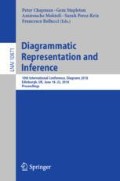Abstract
Euler famously used diagrams to illustrate syllogisms in his Lettres à une princesse d’Allemagne [1]. His diagrams are usually seen as suffering from a fatal “ambiguity problem” [11]: as soon as they involve intersecting circles, which are required for the representation of existential statements, it becomes unclear what exactly may be read off from them, and as Hammer & Shin conclusively showed, any set of reading conventions can lead to erroneous conclusions. I claim that Euler diagrams can, however, be used rigorously, if they are read in conjunction with the premises they are supposed to illustrate. More precisely, I give rigorous “heterogeneous” inference rules (in the sense of Barwise and Etchemendy) – rules whose premises are a sentence and a diagram and whose conclusion is a sentence – which allow to use them safely. I conclude that one should abandon the preconception that diagrams can only be used rigorously if they can be given a context-independent semantics. Finally, I suggest that context-dependence is a widespread feature of diagrams: for instance, Mumma [12] noticed that what may be read off from a Euclidean diagram depends not only on the diagram’s appearance, but also on the way it was constructed.
Access this chapter
Tax calculation will be finalised at checkout
Purchases are for personal use only
Notes
- 1.
See [1, vol. 2, letters cii–cv, pp. 95–126], which is the first published version of didactic letters of Euler’s from 1761 (for details, see [5] or [13, p. 417]). Similar diagrams appear before Euler in a 1661 treatise by Sturm [2, pp. 84–96] and, more systematically, in a 1712 logical text by Johann Christian Lange [3, pp. 249–268] as well as in a 1686 manuscript by Leibniz, unpublished until 1903 [4, pp. 292–321]. See e.g. [14].
- 2.
[1, vol. 2, p. 98]. All translations from the original French are mine.
- 3.
[1, vol. 2, pp. 107–108].
- 4.
[1, vol. 2, p. 113].
- 5.
[1, vol. 2, pp. 121–122].
- 6.
- 7.
I argued that Euler’s diagrams cannot be given a semantics on the sole basis of their appearance: they only make sense when read together with premises they illustrate. But from the point of view of these heterogeneous inference rules, which reconstruct Euler’s practice by teasing apart the roles of diagrams and of premises, matters are different. Indeed, in the context of these rules, one could consider Euler’s diagrams as representing universal statements only: in other words, one could give a diagram the same semantics as the conjunction of all statements “All A are B” and “No C is D” that it displays (in the sense that region A is included in region B and regions C and D do not meet). Such a semantics would make our heterogeneous rules sound. However, note that this semantics for isolated diagrams is a sort of artifact of the formal reconstruction and makes little sense from the point of view of Euler’s practice, in which diagrams are never used independently from the text. In keeping with Euler’s own remarks, it would be more natural to say that e.g. Fig. 1(c) is disambiguated by the context than to claim that it represents nothing at all.
References
Euler, L.: Lettres à une princesse d’Allemagne sur divers sujets de physique & de philosophie. Imprimerie de l’Académie Impériale des Sciences, Saint Pétersbourg (1768)
Sturm, J.C.: Universalia Euclidea. Adrian Vlacq, Hagæ-Comitis [The Hague] (1661)
Lange, J.C.: Nucleus Logicae Weisianae. Henning Müller, Gissae-Hassorum [Giessen] (1712)
Leibniz, G.W.: Opuscules et fragments inédits de Leibniz. Ed. by L. Couturat. F. Alcan, Paris (1903)
Speiser, A.: Einleitung zu den Lettres à une princesse d’Allemagne. In: Euler, L.: Opera Omnia, vol. III/1, pp. VII–XLIII. Orell Füssli, Turici [Zürich] (1960)
Shin, S.J.: The Logical Status of Diagrams. Cambridge University Press, Cambridge (1994)
Hammer, E.M.: Reasoning with sentences and diagrams. Notre Dame J. Form. Log. 35(1), 73–87 (1994)
Barwise, J., Hammer, E.M.: Diagrams and the Concept of Logical System. In: [10], pp. 49–78. Orig. publ. in Gabbay, D.M. (ed.) What Is a Logical System?, pp. 73–106. Clarendon Press, Oxford (1994)
Barwise, J., Etchemendy, J.: Heterogeneous Logic. In: [10], pp. 179–200. Orig. publ. in Glasgow, T.I., Narayanan, N.H., Chandrasekaran, B. (eds.) Diagrammatic Reasoning: Cognitive and Computational Perspectives, pp. 209–232. AAAI Press, Menlo Park and MIT Press, Cambridge (1995)
Allwein, G., Barwise, J. (eds.): Logical Reasoning with Diagrams. Oxford University Press, Oxford (1996)
Hammer, E.M., Shin, S.J.: Euler’s visual logic. Hist. Philos. Log. 19(1), 1–29 (1998)
Mumma, J.: Proofs, pictures, and Euclid. Synthese 175(2), 255–287 (2010)
Calinger, R.S.: Leonhard Euler: Mathematical Genius in the Enlightenment. Princeton University Press, Princeton (2015)
Bennett, D.: Origins of the Venn diagram. In: Zack, M., Landry, E. (eds.) Research in History and Philosophy of Mathematics. PCSHPMSCPM, pp. 105–119. Springer, Cham (2015). https://doi.org/10.1007/978-3-319-22258-5_8
Acknowledgments
I would like to thank Jeremy Avigad, Ken Manders, Nicolas Michel, Marco Panza and David Rabouin for discussions on this topic.
Author information
Authors and Affiliations
Corresponding author
Editor information
Editors and Affiliations
Rights and permissions
Copyright information
© 2018 Springer International Publishing AG, part of Springer Nature
About this paper
Cite this paper
Waszek, D. (2018). Rigor and the Context-Dependence of Diagrams: The Case of Euler Diagrams. In: Chapman, P., Stapleton, G., Moktefi, A., Perez-Kriz, S., Bellucci, F. (eds) Diagrammatic Representation and Inference. Diagrams 2018. Lecture Notes in Computer Science(), vol 10871. Springer, Cham. https://doi.org/10.1007/978-3-319-91376-6_35
Download citation
DOI: https://doi.org/10.1007/978-3-319-91376-6_35
Published:
Publisher Name: Springer, Cham
Print ISBN: 978-3-319-91375-9
Online ISBN: 978-3-319-91376-6
eBook Packages: Computer ScienceComputer Science (R0)

